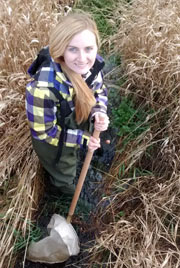Invasive Species Olympics
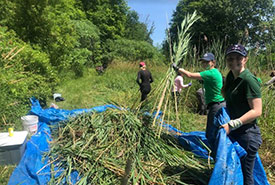
Phragmites javelin (Photo by NCC)
The Olympic Games: the spectacle of international competition, where every four years, thousands of athletes from over 200 countries compete in the pinnacle of their sport. Inspired by the ancient Olympic Games, first held in Olympia, Greece, in the 8th century BCE, the modern rendition was reborn in 1894. Since then, it has expanded to include the Olympic Winter Games, the Paralympic Games and the Continental Games. With more than 408 events, ranging from surfing to ski jumping, there is something for every athlete.
It is unlikely that anyone on the Nature Conservancy of Canada’s (NCC’s) eastern Ontario stewardship team will ever become an Olympic athlete. However, for those conservation biologists (professional or amateur) who want to try their hand at a multi-sport games, might I suggest the Invasive Species Olympics?
Trying to combat invasive species sometimes feels like a competition. The goal of restoring ecological function and habitat for native species (especially species at risk) is our gold medal. An invasive species is one that does not naturally belong in an area, and its presence causes damage to the environment, the economy and/or society. At NCC, we use a variety of methods to control invasive plant species, but all of them usually involve a lot of elbow grease and sweat.
It’s pretty rare that an athlete can compete in more than one Olympic sport. However, in the Invasive Species Olympics, an athlete must be multi-disciplined. According to the Early Detection and Distribution Mapping System (EDDMapS), there are 196 invasive species in Ontario, and each requires a slightly different approach to eradicate.
Related blog posts
So, what kind of sports can you expect to see in the Invasive Species Olympics – Eastern Ontario Edition?
Phragmites javelin
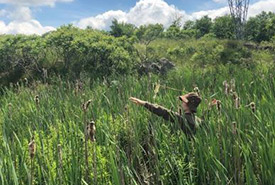
Phragmites javelin (Photo by NCC)
Manually removing phragmites (a.k.a. common reed) is hard. It’s hot, it’s wet, and there’s something especially daunting about being stuck in a dense patch of grass that can grow up to five metres tall. One of the hardest parts of controlling smaller populations is figuring out how to carry the phragmites stems out of the wetland. Leaving behind plant material can encourage new growth, so it’s important to remove it.
We’ve discovered that phragmites javelin is a great way to collect the material in one location, before the stems develop seed heads. The crew has become very good at launching the stalks from the wetland onto tarps placed in an open area so that they can be safely removed. Phragmites javelin should always be enjoyed safely to make sure you aren’t spreading plant material.
Dog-strangling vine marathon
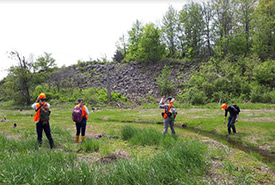
Dog-strangling vine marathon (Photo by NCC)
A lot of the invasive species we control in eastern Ontario are found close to where people live and play. While spending time outdoors, people may unknowingly bring invasive seeds and plant parts with them. This leads to high concentrations of invasive plant species around trails or parking lots. But sometimes, they pop up away from everything.
There is a dog-strangling vine population in eastern Ontario that takes a few hours for the team to hike to while carrying lots of heavy equipment. Then, after spending time controlling the population, we have to hike back out. This daunting marathon is enough to break anyone’s spirits, but as with any Olympic team sport, it’s all about communication and encouraging each other. It’s been estimated that during a marathon, a runner will take over 50,000 steps, and although dog-strangling vine marathons usually only take me about 30,000 steps on average, it still feels like I’ve finished a marathon in the end.
Common buckthorn rowing
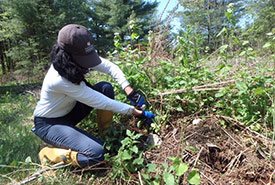
Common buckthorn rowing (Photo by NCC)
One of the ways to remove invasive buckthorn trees is by cutting them down. You can easily pull the small stems out of the ground, but once they reach a certain size, you have to use a hand saw. It’s important to use good posture and technique when using tools because health and safety is a priority while in the field. Buckthorn removal happens in the shoulder seasons, so that we avoid disturbing nesting birds. Unfortunately, this means many days in a row are spent controlling it. After hours of sawing back and forth, you start to feel like an Olympic rower.
Garlic mustard swimming
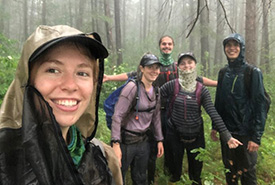
Garlic mustard swimming (Photo by NCC)
It’s a given that when working outside, you’re going to have to deal with the weather. I try my best to plan the work week around the conditions, but sometimes the job just needs to get done.
The other week, while trying to remove a patch of garlic mustard, my field crew and I found ourselves practically swimming when it started to downpour as we were finishing up for the day. Thankfully, everyone took it in stride, even though we had a very wet, two-hour car ride home after. When it feels like you’re swimming while standing up, you know you’re competing in the Invasive Species Olympics.
Purple loosestrife gymnastics
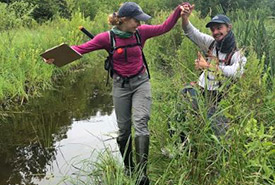
Purple loosestrife gymnastics (Photo by NCC)
Monitoring for invasive species is just as important as controlling it. By knowing how big and dense a population is, we can devise a strategy for eradicating it. Unfortunately, invasive species aren’t always found in convenient places. While monitoring a patch of purple loosestrife this summer, Ally Belanger, assistant conservation biologist, made use of her gymnastic skills while navigating a balance beam of flooded trail (with a helpful spot from conservation technician Andrew Colton. We gave her a 10/10 for still being dry on the other side).
If they handed out medals for the Invasive Species Olympics, the eastern Ontario stewardship team would win gold. The next time you’re removing invasive species, maybe at an NCC Conservation Volunteers event, remember that you are an athlete, and your contribution to the ecosystem does not go unnoticed.

